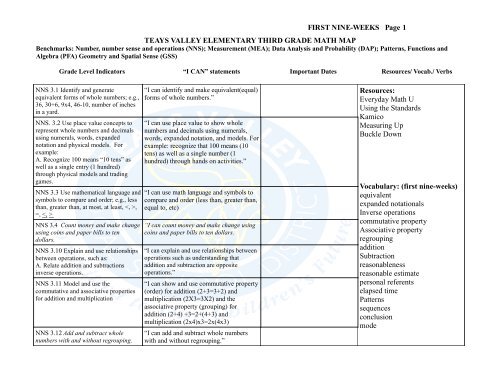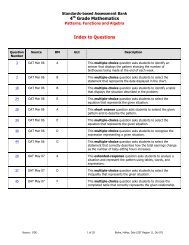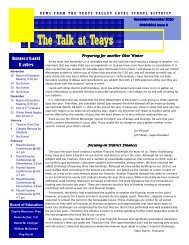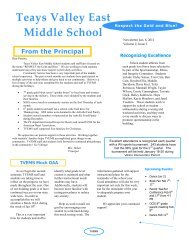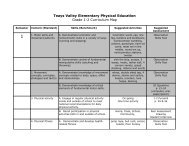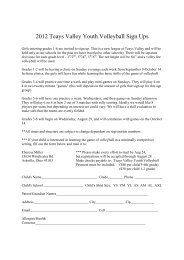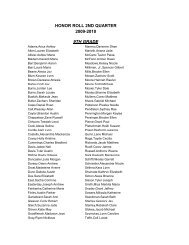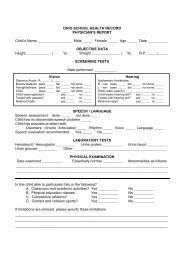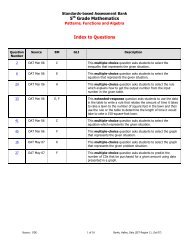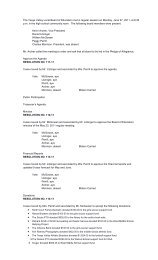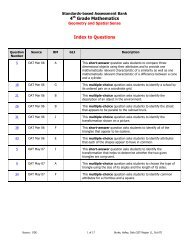Math "I Can" Statements
Math "I Can" Statements
Math "I Can" Statements
Create successful ePaper yourself
Turn your PDF publications into a flip-book with our unique Google optimized e-Paper software.
FIRST NINE-WEEKS Page 1<br />
TEAYS VALLEY ELEMENTARY THIRD GRADE MATH MAP<br />
Benchmarks: Number, number sense and operations (NNS); Measurement (MEA); Data Analysis and Probability (DAP); Patterns, Functions and<br />
Algebra (PFA) Geometry and Spatial Sense (GSS)<br />
Grade Level Indicators “I CAN” statements Important Dates Resources/ Vocab./ Verbs<br />
NNS 3.1 Identify and generate<br />
equivalent forms of whole numbers; e.g.,<br />
36, 30+6, 9x4, 46-10, number of inches<br />
in a yard.<br />
NNS. 3.2 Use place value concepts to<br />
represent whole numbers and decimals<br />
using numerals, words, expanded<br />
notation and physical models. For<br />
example:<br />
A. Recognize 100 means “10 tens” as<br />
well as a single entry (1 hundred)<br />
through physical models and trading<br />
games.<br />
NNS 3.3 Use mathematical language and<br />
symbols to compare and order; e.g., less<br />
than, greater than, at most, at least, ,<br />
=, <br />
NNS 3.4 Count money and make change<br />
using coins and paper bills to ten<br />
dollars.<br />
NNS 3.10 Explain and use relationships<br />
between operations, such as:<br />
A. Relate addition and subtractions<br />
inverse operations.<br />
NNS 3.11 Model and use the<br />
commutative and associative properties<br />
for addition and multiplication<br />
NNS 3.12 Add and subtract whole<br />
numbers with and without regrouping.<br />
“I can identify and make equivalent(equal)<br />
forms of whole numbers.”<br />
“I can use place value to show whole<br />
numbers and decimals using numerals,<br />
words, expanded notation, and models. For<br />
example: recognize that 100 means (10<br />
tens) as well as a single number (1<br />
hundred) through hands on activities.”<br />
“I can use math language and symbols to<br />
compare and order (less than, greater than,<br />
equal to, etc)<br />
“I can count money and make change using<br />
coins and paper bills to ten dollars.<br />
“I can explain and use relationships between<br />
operations such as understanding that<br />
addition and subtraction are opposite<br />
operations.”<br />
“I can show and use commutative property<br />
(order) for addition (2+3=3+2) and<br />
multiplication (2X3=3X2) and the<br />
associative property (grouping) for<br />
addition (2+4) +3=2+(4+3) and<br />
multiplication (2x4)x3=2x(4x3)<br />
“I can add and subtract whole numbers<br />
with and without regrouping.”<br />
Resources:<br />
Everyday <strong>Math</strong> U<br />
Using the Standards<br />
Kamico<br />
Measuring Up<br />
Buckle Down<br />
Vocabulary: (first nine-weeks)<br />
equivalent<br />
expanded notationals<br />
Inverse operations<br />
commutative property<br />
Associative property<br />
regrouping<br />
addition<br />
Subtraction<br />
reasonableness<br />
reasonable estimate<br />
personal referents<br />
elapsed time<br />
Patterns<br />
sequences<br />
conclusion<br />
mode
FIRST NINE-WEEKS Page 2<br />
TEAYS VALLEY ELEMENTARY THIRD GRADE MATH MAP<br />
Benchmarks: Number, number sense and operations (NNS); Measurement (MEA); Data Analysis and Probability (DAP); Patterns, Functions and<br />
Algebra (PFA) Geometry and Spatial Sense (GSS)<br />
Grade Level Indicators “I CAN” statements Important Dates Resources/ Vocab./ Verbs<br />
NNS 3.15 Evaluate the reasonableness<br />
of computations based upon operations<br />
and the numbers involved; e.g.,<br />
considering relative size, place value and<br />
estimates.<br />
MEA 3.2 Establish personal or common<br />
referents to include additional units; e.g.,<br />
a gallon container of milk; a postage<br />
stamp is about a square inch<br />
MEA 3.3 Tell time to the nearest minute<br />
and find elapsed time using a calendar<br />
or a clock.<br />
PFA 3.1 Extend multiplicative and<br />
growing patterns, and describe the<br />
pattern or rule in words.<br />
PFA 3.2 Analyze and replicate arithmetic<br />
sequences with and without a calculator.<br />
PFA 3.3 Use patterns to make prediction,<br />
identify relationships, and solve<br />
problems.<br />
PFA 3.4 Model problem situations using<br />
objects, pictures, tables, numbers, letters<br />
and other symbols.<br />
PFA 3.7 Create tables to record,<br />
organize and analyze data to discover<br />
patterns and rules.<br />
DAP 3.4 Support a conclusion or<br />
predication orally and in writing, using<br />
information in a table or graph.<br />
DAP 3.5 Match a set of data with a<br />
graphical representation of the data.<br />
I can decide whether an answer makes<br />
sense.”<br />
“I can list items that are the same size of<br />
common units ( a gallon of milk; a postage<br />
stamp is about a square inch.”<br />
“I can find elapsed time using a calendar<br />
or clock.”<br />
“I can describe the multiplication pattern<br />
or state the rule in words.”<br />
“I can find the number sequence, with and<br />
without a calculator.”<br />
“I can use patterns to make predictions and<br />
solve problems.”<br />
“I can solve problems by using objects,<br />
pictures, tables, numbers, letters and other<br />
symbols.”<br />
“I can make tables to record information<br />
to find patterns and rules.”<br />
“I can use information in a table or graph<br />
to support a prediction.”<br />
“I can match correct information with a<br />
graph.”
FIRST NINE-WEEKS Page 3<br />
TEAYS VALLEY ELEMENTARY THIRD GRADE MATH MAP<br />
Benchmarks: Number, number sense and operations (NNS); Measurement (MEA); Data Analysis and Probability (DAP); Patterns, Functions and<br />
Algebra (PFA) Geometry and Spatial Sense (GSS)<br />
Grade Level Indicators “I CAN” statements Important Dates Resources/ Vocab./ Verbs<br />
DAP 3.6 Translate information freely<br />
among charts, tables, line plots, picture<br />
graphs and bar graphs; e.g., create a bar<br />
graph from the information in a chart.<br />
“I can move information freely among<br />
charts, tables, line plots, picture graphs,<br />
and bar graphs.”<br />
DAP 3.8 Identify the mode of a data set<br />
and describe the information it gives<br />
about a data set.<br />
DAP 3.9 Conduct a simple experiment<br />
or simulation of a simple event, record<br />
the results in a chart, table or graph, and<br />
use the results to draw conclusions about<br />
the likelihood of possible outcomes.<br />
“I can find the mode (number that appears<br />
most often) and describe the information it<br />
gives.”<br />
“I can do a simple experiment, record the<br />
results, and draw conclusions about what<br />
will happen.”
SECOND NINE-WEEKS Page 4<br />
TEAYS VALLEY ELEMENTARY THIRD GRADE MATH MAP<br />
Benchmarks: Number, number sense and operations (NNS); Measurement (MEA); Data Analysis and Probability (DAP); Patterns, Functions and<br />
Algebra (PFA) Geometry and Spatial Sense (GSS)<br />
Grade Level Indicators “I CAN” statements Important Dates Resources/ Vocab./ Verbs<br />
NNS 3.3 Use mathematical language and<br />
symbols to compare and order; e.g., less<br />
than, greater than, at most, at least, ,<br />
=, <br />
NNS 3.9 Model, represent and explain<br />
division; e.g., sharing equally, repeated<br />
subtraction, rectangular arrays and area<br />
model. For example:<br />
A. Translate contextual situations<br />
involving division into conventional<br />
mathematical symbols.<br />
B. Explain how a remainder may impact<br />
an answer in a real-world situation; e.g.,<br />
14 cookies being shared by 4 children.<br />
NNS 3.10 Explain and use relationships<br />
between operations, such as:<br />
B. Relate multiplication and division as<br />
inverse operations<br />
C. Relate addition to multiplication (repeated<br />
addition)<br />
D. Relate subtraction to division (repeated<br />
subtraction)<br />
NNS 3.11 Model and use the<br />
commutative and associative properties<br />
for addition and multiplication.<br />
NNS 3.12 Add and subtract whole<br />
numbers with and without regrouping.<br />
NNS 3.13 Demonstrate fluency in<br />
multiplication facts through 10 and<br />
corresponding division facts.<br />
“I can use math language and symbols to<br />
compare and order (less than, greater than,<br />
equal to, greater than or equal, less than or<br />
equal to, , =, .”<br />
“I can explain division by using repeated<br />
subtraction, arrays, sharing equally, and<br />
area model, for example:<br />
“I can write story problems for division.”<br />
“I can identify what a remainder means in<br />
a division story problem.”<br />
“I can explain and use relationship between<br />
operations such as:<br />
*understand multiplication and division as<br />
opposite operations.<br />
*understand that multiplication is repeated<br />
addition.<br />
*understand that division is repeated subtraction.”<br />
“I can show and use the commutative property<br />
(order) for addition and multiplication and<br />
associative property (grouping) for addition and<br />
multiplication.”<br />
“I can add and subtract whole numbers with<br />
and without grouping.”<br />
“I can show I know my multiplication<br />
facts through 10 and division facts through<br />
10.”<br />
Vocabulary: 2 nd nine-weeks<br />
fractions<br />
mixed numbers<br />
model<br />
arrrays<br />
remainders<br />
inverse operations
SECOND NINE-WEEKS Page 5<br />
TEAYS VALLEY ELEMENTARY THIRD GRADE MATH MAP<br />
Benchmarks: Number, number sense and operations (NNS); Measurement (MEA); Data Analysis and Probability (DAP); Patterns, Functions and<br />
Algebra (PFA) Geometry and Spatial Sense (GSS)<br />
Grade Level Indicators “I CAN” statements Important Dates Resources/ Vocab./ Verbs<br />
MEA 3.1 Identify and select appropriate units<br />
for measuring:<br />
A. Length – miles, kilometers and other units<br />
of measure as appropriate;<br />
C. Weight – ounces, pounds, grams, or<br />
kilograms;<br />
D. Temperature – degrees (Fahrenheit or<br />
Celsius).<br />
MEA 3.2 Establish personal or<br />
common referents to include additional<br />
units; e.g., a gallon container of milk;<br />
a postage stamp is about a square inch<br />
MEA 3.3 Tell time to the nearest<br />
minute and find elapsed time using a<br />
calendar or a clock<br />
MEA 3.4 Read thermometers in both<br />
Fahrenheit and Celsius scales.<br />
MEA 3.5 Estimate and measure length,<br />
weight and volume (capacity), using<br />
metric and U.S. customary units,<br />
accurate to the nearest ½ or ¼ unit as<br />
appropriate.<br />
MEA 3.7 Make estimates for perimeter,<br />
area and volume using links, tiles, cubes<br />
and other models.<br />
PFA 3.1 Extend multiplicative and<br />
growing patterns,and describe the<br />
patterns or rule in words<br />
PFA 3.7 Create tables to record,<br />
organize and analyze data to discover<br />
patterns and rules.<br />
“I can name and choose the correct units for<br />
measuring; length- miles, kilometers and other<br />
units of measure; weight- ounces,pounds, grams,<br />
or kilograms; temperature-degrees (Fahrenheit or<br />
Celsius.”<br />
“I can list items that are the same size in<br />
common units ( a gallon container of milk;<br />
a postage stamp in about a square inch.”<br />
“I can find elapsed time using a calendar<br />
or clock.”<br />
“I can read thermometers in both<br />
Fahrenheit and Celsius scales.”<br />
“I can estimate and measure length,<br />
weight, and volume (capacity), using<br />
metric U.S. Customary units.”<br />
“I can estimate the perimeter, area, and<br />
volume using manipulatives.”<br />
“I can describe the multiplication pattern<br />
or state the rule in words.”<br />
“I can make tables to record information<br />
to find patterns and rules.”
SECOND NINE-WEEKS Page 6<br />
TEAYS VALLEY ELEMENTARY THIRD GRADE MATH MAP<br />
Benchmarks: Number, number sense and operations (NNS); Measurement (MEA); Data Analysis and Probability (DAP); Patterns, Functions and<br />
Algebra (PFA) Geometry and Spatial Sense (GSS)<br />
Grade Level Indicators “I CAN” statements Important Dates Resources/ Vocab./ Verbs<br />
DAP 3.6 Translate information freely<br />
among charts, tables, line plots,<br />
picture graphs and bar graphs; eg.<br />
Create a bar graph from the<br />
information in a chart<br />
DAP 3.8 Identify the mode of a data<br />
set and describe the information it<br />
gives about a data set<br />
“I can move information freely among<br />
charts, tables, line plots, picture graphs,<br />
and bar graphs.”<br />
“I can find the mode (number that appears<br />
most often) and describe the information it<br />
gives.”
THIRD NINE-WEEKS Page 7<br />
TEAYS VALLEY ELEMENTARY THIRD GRADE MATH MAP<br />
Benchmarks: Number, number sense and operations (NNS); Measurement (MEA); Data Analysis and Probability (DAP); Patterns, Functions and<br />
Algebra (PFA) Geometry and Spatial Sense (GSS)<br />
Grade Level Indicators “I CAN” statements Important Dates Resources/ Vocab./ Verbs<br />
NNS 3.2 Use place value concepts to<br />
represent whole numbers and decimals<br />
using numerals, works, expanded<br />
notation and physical models. For<br />
example:<br />
B. Describe the multiplicative nature of<br />
the number system; e.g., the structure of<br />
3205 as 3x1000 plus 2x100 plus 5x1<br />
C. Model the size of 1000 in multiple<br />
ways; e.g., packaging 1000 objects into<br />
10 boxes of 100, modeling a meter with<br />
centimeter and decimeter strips, or<br />
gathering 1000 pop-can tabs.<br />
D. Explain the concept of tenths and<br />
hundredths using physical models, such<br />
as metric pieces, base ten blocks, decimal<br />
squares or money.<br />
NNS 3.3 Use mathematical language and<br />
symbols to compare and order; e.g., less than,<br />
greater than, at most, at least, , =, <br />
NNS 3.11 Model and use the<br />
commutative and associative properties<br />
for addition and multiplication.<br />
NNS 3.13 Demonstrate fluency in<br />
multiplication facts through 10 and<br />
corresponding division facts<br />
NNS 3.5 Represent fractions and<br />
mixed numbers using words, numerals<br />
and physical modes<br />
NNS 3.4 Count money and make change<br />
using coins and paper bills to ten dollars<br />
“I can use place value to show whole<br />
numbers and decimals using numerals,<br />
words, expanded notation and models. For<br />
example:b. Describe the expanded form of<br />
multiplication (3205 as 3x1000 plus 2x100<br />
plus 5x1)<br />
c. Show the size of 1,000 in many ways<br />
(packaging 1,000 objects into 10 boxes of<br />
100, modeling a meter with centimeter and<br />
decimeter strips, or gathering 1,ooo pop<br />
tabs)<br />
d. Explain the idea of tenths and<br />
hundredths using a variety of objects, such<br />
as metric pieces, base ten blocks, decimal<br />
squares, or money.”<br />
“I can use math language and symbols to compare<br />
order (less than, greater than, equal to, etc..)<br />
“I can show and use the commutative property<br />
(order) for addition and multiplication and<br />
associative property (grouping) for addition and<br />
multiplication.”<br />
“I can show I know my multiplication<br />
facts through 10 and division facts through<br />
10.”<br />
“I can show fractions and mixed numbers<br />
using words, numerals and pictures.”<br />
“ I can count money and make change<br />
using coins and paper bill to ten dollars.<br />
Vocabulary 3 rd nine-weeks<br />
(GSS)<br />
tenths<br />
hundredths<br />
vertex<br />
edge<br />
angle<br />
side<br />
face<br />
right angle<br />
acute<br />
obtuse<br />
symmetry<br />
three-dimensional
THIRD NINE-WEEKS Page 8<br />
TEAYS VALLEY ELEMENTARY THIRD GRADE MATH MAP<br />
Benchmarks: Number, number sense and operations (NNS); Measurement (MEA); Data Analysis and Probability (DAP); Patterns, Functions and<br />
Algebra (PFA) Geometry and Spatial Sense (GSS)<br />
Grade Level Indicators “I CAN” statements Important Dates Resources/ Vocab./ Verbs<br />
NNS 3.12 Add and subtract whole<br />
numbers with and without regrouping<br />
PFA 3.1 Extend multiplicative and<br />
growing patterns, and describe the<br />
pattern or rule in words<br />
PFA 3.5 Write, solve and explain simple<br />
mathematical statements, such as 7+ >8<br />
or +8=10.<br />
PFA 3.6 Express mathematical<br />
relationships as equations and<br />
inequalities.<br />
PFA 3.7 Create tables to record,<br />
organize and analyze data to discover<br />
patterns and rules<br />
GSS 3.1 Analyze and describe properties<br />
of two-dimensional shapes and threedimensional<br />
objects using terms such as<br />
vertex, edge, angle, side and face.<br />
GSS 3.2 Identify and describe the<br />
relative size of angles with respect to<br />
right angles as follows:<br />
A. Use physical models, like straws, to<br />
make different sized angles by opening<br />
and closing the sides, not by changing<br />
the side lengths.<br />
B. Identify, classify and draw right,<br />
acute, obtuse and straight angles.<br />
GSS 3.3 Find and name locations on a<br />
labeled grid or coordinate system; e.g., a<br />
map or graph.<br />
“I can add and subtract whole numbers with<br />
and without grouping.”<br />
“I can describe the multiplication pattern<br />
or state the rule in words.”<br />
“I can write, solve, and explain simple<br />
number sentences, where there is a<br />
missing number.”<br />
“I can write number sentences using<br />
symbols =, .”<br />
“I can make tables to record information<br />
to find patterns and rules.”<br />
“I can identify the vertex, edge, angle,<br />
side, and face of a shape.”<br />
“I can identify, draw and make models of<br />
right, obtuse, acute and straight angles.”<br />
“I can plot a point on a grid.”
THIRD NINE-WEEKS Page 9<br />
TEAYS VALLEY ELEMENTARY THIRD GRADE MATH MAP<br />
Benchmarks: Number, number sense and operations (NNS); Measurement (MEA); Data Analysis and Probability (DAP); Patterns, Functions and<br />
Algebra (PFA) Geometry and Spatial Sense (GSS)<br />
Grade Level Indicators “I CAN” statements Important Dates Resources/ Vocab./ Verbs<br />
GSS 3.4 Draw lines of symmetry to<br />
verify symmetrical two-dimensional<br />
shapes.<br />
GSS 3.5 Build a three-dimensional<br />
model of an object composed of cubes;<br />
e.g., construct a model based on an<br />
illustration or actual object.<br />
MEA 3.1 Identify and select appropriate<br />
units for measuring:<br />
B. Volume (capacity) – gallons:<br />
MEA 3.2 Establish personal or<br />
common referents to include additional<br />
units; e.g. gallon container of milk; a<br />
postage stamp is a square inch.<br />
MEA 3.5 Estimate and measure length,<br />
weight and volume (capacity), using<br />
metric and U.S. customary units,<br />
accurate to the nearest ½ or ¼ unit as<br />
appropriate.<br />
MEA 3.6 Use appropriate measurement<br />
tools and techniques to construct a figure<br />
or approximate an amount of specified<br />
length, weight or volume (capacity); e.g.,<br />
construct a rectangle with length 2 ½<br />
inches and width 3 inches, file a<br />
measuring cup to the ¾ cup mark.<br />
MEA 3.7 Make estimates for perimeter,<br />
area and volume using links, tiles, cubes<br />
and other models.<br />
MEA 3.3 Tell time to the nearest minute and<br />
find elapsed time using a calendar or<br />
clock<br />
“I can find and draw lines of symmetry.”<br />
“I can build a three-dimensional model of<br />
an object using cubes.”<br />
“ I can name and choose the correct units<br />
for measuring, such as volume (capacity)-<br />
gallons<br />
“I can list items that are the same size in<br />
common units ( a gallon container of milk;<br />
a postage stamp in about a square inch.”<br />
“I can estimate and measure length,<br />
weight, and volume (capacity) using<br />
metric and U.S. Customary units.”<br />
“ I can use correct measurement tools and<br />
methods.”<br />
“I can estimate the perimeter, area, and<br />
volume using manipulatives.”<br />
“I can find elapsed time using a calendar<br />
or clock.”
THIRD NINE-WEEKS Page 10<br />
TEAYS VALLEY ELEMENTARY THIRD GRADE MATH MAP<br />
Benchmarks: Number, number sense and operations (NNS); Measurement (MEA); Data Analysis and Probability (DAP); Patterns, Functions and<br />
Algebra (PFA) Geometry and Spatial Sense (GSS)<br />
Grade Level Indicators “I CAN” statements Important Dates Resources/ Vocab./ Verbs<br />
DAP 3.3 Read, interpret and construct<br />
bar graphs with intervals greater than<br />
one.<br />
DAP 3.7 Analyze and interpret<br />
information represented on a time line.<br />
DAP 3.6 Translate information freely<br />
among charts, tables, line plots,<br />
picture graphs; e.g. create bar graphs<br />
from the information in a chart<br />
DAP 3.8 Identify the mode of a data<br />
set and describe the information it<br />
gives about a data set<br />
“I can read, make and understand bar<br />
graphs with spaces greater than one.”<br />
“I can understand information shown on a<br />
time line.”<br />
“I can move information freely among<br />
charts, tables, line plots, picture graphs,<br />
and bar graphs.”<br />
“I can find the mode (number that appears<br />
most often) and describe the information it<br />
gives.”
FOURTH NINE-WEEKS Page 11<br />
TEAYS VALLEY ELEMENTARY THIRD GRADE MATH MAP<br />
Benchmarks: Number, number sense and operations (NNS); Measurement (MEA); Data Analysis and Probability (DAP); Patterns, Functions and<br />
Algebra (PFA) Geometry and Spatial Sense (GSS)<br />
Grade Level Indicators “I CAN” statements Important Dates Resources/ Vocab./ Verbs<br />
NNS 3.4 Count money and make change<br />
using coins and paper bills to ten.”<br />
NNS 3.13 Demonstrate fluency in<br />
multiplication facts through 10 and<br />
corresponding division facts.<br />
NNS 3.14 Multiply and divide 2- and 3-<br />
digit numbers by a single-digit number,<br />
without remainders for division.<br />
DAP 3.1 Collect and organize data from<br />
an experiment, such as recording and<br />
classifying observations or<br />
measurements, in response to a question<br />
posed.<br />
DAP 3.9 Conduct a simple experiment<br />
or simulation of a simple event, record<br />
the results in a chart, table, graph, and<br />
use the results to draw conclusions about<br />
the likelihood of possible outcomes.<br />
DAP 3.10 Use physical models, pictures,<br />
diagrams and lists to solve problems<br />
involving possible arrangements or<br />
combinations or two to four objects.<br />
PFA 3.8 Identify and describe<br />
quantitative changes,especially those<br />
involving addition and subtraction; e.g.,<br />
the height of water in a glass becoming 1<br />
centimeter lower each week due to<br />
evaporation.<br />
“I can count money and make change<br />
using coins and paper bills to ten dollars.”<br />
“I can show I know my multiplication<br />
facts through 10 and division facts through<br />
10.”<br />
“I can multiply 2- and 3- digit numbers by<br />
a single digit number (without remainders<br />
for division) I can divide 2- and 3- digit<br />
numbers by a single-digit number.”<br />
“I can collect and organize information<br />
from an experiment to answer a question.<br />
“I can do a simple experiment, record the<br />
results, and draw conclusions about what<br />
will happen.”<br />
“ I can solve problems by making different<br />
combinations of two to four items.”<br />
“I can identify the change in amount, by<br />
using addition and subtraction.”
TEAYS VALLEY ELEMENTARY THIRD GRADE MATH MAP<br />
Benchmarks: Number, number sense and operations (NNS); Measurement (MEA); Data Analysis and Probability (DAP); Patterns, Functions and<br />
Algebra (PFA) Geometry and Spatial Sense (GSS)<br />
Grade Level Indicators “I CAN” statements Important Dates Resources/ Vocab./ Verbs<br />
NNS 3.5 Represent fractions and mixed<br />
numbers using words numerals and<br />
physical models<br />
NNS 3.12 Add and subtract whole<br />
numbers with and without regrouping<br />
DAP 3.3 Read, interpret and construct<br />
bar graphs with intervals greater than<br />
one<br />
DAP 3.6 Translate information freely<br />
among charts, tables, line plots,<br />
picture graphs; e.g. create a bar graph<br />
from the information in a chart<br />
DAP 3.8 Identify the mode of a data<br />
set and describe the information it<br />
gives about the data set<br />
GSS 3.1 Analyze and describe<br />
properties of two-dimensional shapes<br />
and three-dimensional objects using<br />
terms such as vertex, edge, angle, side<br />
and face.<br />
GSS 3.3 Find and name locations on a<br />
labeled grid or coordinate system; e.g., a<br />
map or graph.<br />
GSS 3.4 Draw lines of symmetry to<br />
verify symmetrical two-dimensional<br />
shapes.<br />
MEA 3.2 Establish personal or<br />
common referents to include additional<br />
units; e.g. gallon container of milk; a<br />
postage stamp is a square inch.<br />
“I can show fractions and mixed numbers<br />
using words, numerals and pictures.”<br />
“I can add and subtract whole numbers with<br />
and without grouping.”<br />
“I can read, make and understand bar<br />
graphs with spaces greater than one.”<br />
“I can move information freely among<br />
charts, tables, line plots, picture graphs,<br />
and bar graphs.”<br />
“I can find the mode (number that appears<br />
most often) and describe the information it<br />
gives.”<br />
“I can identify the vertex, edge, angle,<br />
side, and face of a shape.”<br />
“I can plot a point on a grid.”<br />
“I can find and draw lines of symmetry.”<br />
“I can list items that are the same size in<br />
common units ( a gallon container of milk;<br />
a postage stamp in about a square inch.”<br />
FOURTH NINE-WEEKS Page 12
FOURTH NINE-WEEKS Page 13<br />
TEAYS VALLEY ELEMENTARY THIRD GRADE MATH MAP<br />
Benchmarks: Number, number sense and operations (NNS); Measurement (MEA); Data Analysis and Probability (DAP); Patterns, Functions and<br />
Algebra (PFA) Geometry and Spatial Sense (GSS)<br />
Grade Level Indicators “I CAN” statements Important Dates Resources/ Vocab./ Verbs<br />
MEA 3.7 Make estimates for perimeter,<br />
area and volume using links, tiles, cubes<br />
and other models.<br />
MEA 3.3 Tell time to the nearest<br />
minute and find elapsed time using a<br />
calendar or clock<br />
PFA 3.1 Extend multiplicative and<br />
growing patterns, and describe the<br />
pattern or rule in words<br />
PFA 3.5 Write, solve and explain simple<br />
mathematical statements, such as 7+ >8<br />
or +8=10.<br />
PFA 3.7 Create tables to record,<br />
organize and analyze data to discover<br />
patterns and rules<br />
“I can estimate the perimeter, area, and<br />
volume using manipulatives.”<br />
“I can find elapsed time using a calendar<br />
or clock.”<br />
“I can describe the multiplication pattern<br />
or state the rule in words.”<br />
“I can write, solve, and explain simple<br />
number sentences, where there is a<br />
missing number.”<br />
“I can make tables to record information<br />
to find patterns and rules.”


